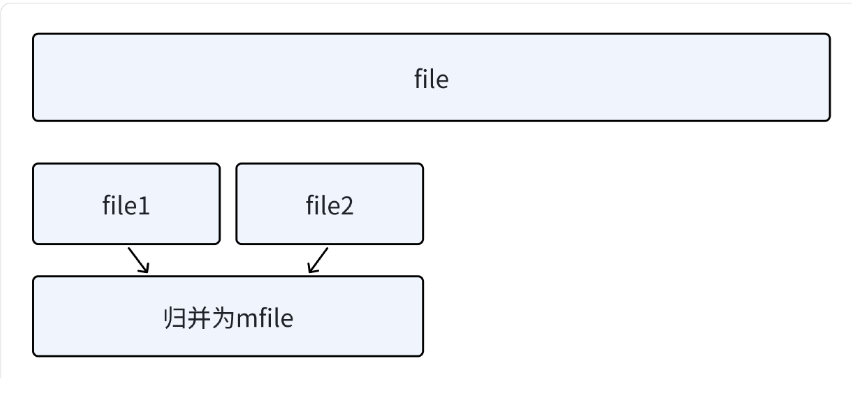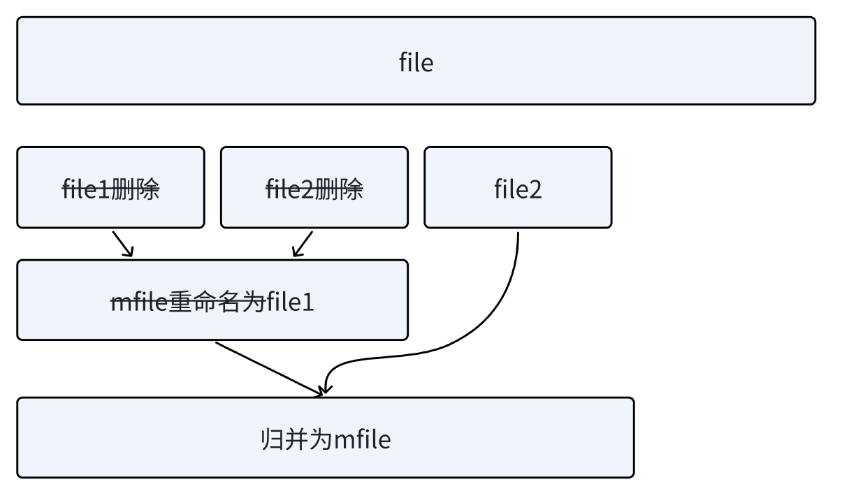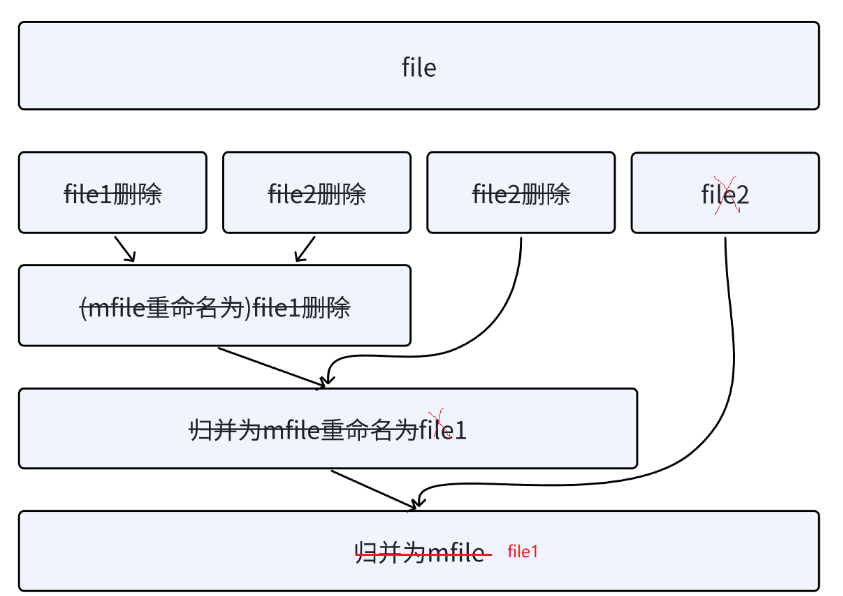【数据结构初阶】--文件归并排序
🔥个人主页:@草莓熊Lotso 🎬作者简介:C++研发方向学习者 📖个人专栏: 《C语言》 《数据结构与算法》《C语言刷题集》《Leetcode刷题指南》 ⭐️人生格言:生活是默默的坚持,毅力是永久的享受。
前言:在前面我们完成了大部分常见排序算法的实现,今天这篇博客和之前的快速排序进阶一样,属于特别篇,大家可以选择性的看。如果前面的知识点都掌握的不错的话,可以了解一下这个文件的归并排序
文件归并排序
在日常编程中,我们经常需要对数据进行排序,但当数据量超过内存容量时,普通的内存排序算法就显得力不从心了。文件归并排序(External Merge Sort)正是解决这一问题的经典方案,它能高效处理超出内存限制的大型数据排序。博主将详细给介绍如何用C语言实现文件归并排序,从原理到代码一步到位。
什么是文件归并排序:
文件归并排序属于外部排序算法,核心思想是分而治之:
- 1. 将大型文件分割成多个能被内存容纳的小文件
- 2. 用内存排序算法(如快速排序)对每个小文件排序
- 3. 逐步合并这些有序小文件,最终得到完整的有序大文件
这种方式突破了内存容量限制,特别适合处理GB级甚至更大的数据集。
文件排序的实现思路:
1. 分割文件:
- 设定内存缓冲区大小(如1MB),每次从原文件读取缓冲区大小的数据
- 对缓冲区数据进行内存排序(如qsort)
- 将排序后的缓冲区数据写入临时小文件
- 重复上述步骤,直到原文件所有数据处理完毕
2. 合并文件:
- 采用"两两归并"策略,每次合并两个有序小文件为一个更大的有序文件
- 若小文件数量为奇数,最后一个文件直接进入下一轮合并
- 重复合并过程,直到最终只剩一个文件
3.清理合并完成后删除的文件
大致过程:
- 1.读取n个值排序后写到file1,再读取n个值排序后写到file2
- 2.file1和file2利用归并排序的思想,依次读取比较,取小的尾插到mfile,mfile归并为一个有序文件
- 3.将file1和file2删掉,mfile重命名为file1再次读取n个数据排序后写到file2
- 4.继续走file1和fie2归并,重复步骤2,直到文件中无法读出数据。最后归并出的有序数据放到了file1中
如图所示:



代码实现:
#define _CRT_SECURE_NO_WARNINGS 1
#include<stdio.h>
#include<time.h>
#include<stdlib.h>
// 创建N个随机数,写到文件中
void CreateNDate()
{
// 造数据
int n = 10000000;
srand(time(0));
const char* file = "data.txt";
FILE* fin = fopen(file, "w");
if (fin == NULL)
{
perror("fopen error");
return;
}
for (int i = 0; i < n; ++i)
{
int x = rand() + i;
fprintf(fin, "%d\n", x);
}
fclose(fin);
}
int compare(const void* a, const void* b)
{
return (*(int*)a - *(int*)b);
}
// 返回实际读到的数据个数,没有数据了,返回0
int ReadNDataSortToFile(FILE* fout, int n, const char* file1)
{
int x = 0;
int* a = (int*)malloc(sizeof(int) * n);
if (a == NULL)
{
perror("malloc error");
return 0;
}
// 想读取n个数据,如果遇到文件结束,应该读到j个
int j = 0;
for (int i = 0; i < n; i++)
{
if (fscanf(fout, "%d", &x) == EOF)
break;
a[j++] = x;
}
if (j == 0)
{
free(a);
return 0;
}
// 排序
qsort(a, j, sizeof(int), compare);
FILE* fin = fopen(file1, "w");
if (fin == NULL)
{
free(a);
perror("fopen error");
return 0;
}
// 写回file1文件
for (int i = 0; i < j; i++)
{
fprintf(fin, "%d\n", a[i]);
}
free(a);
fclose(fin);
return j;
}
void MergeFile(const char* file1, const char* file2, const char* mfile)
{
FILE* fout1 = fopen(file1, "r");
if (fout1 == NULL)
{
perror("fopen error");
return;
}
FILE* fout2 = fopen(file2, "r");
if (fout2 == NULL)
{
perror("fopen error");
return;
}
FILE* mfin = fopen(mfile, "w");
if (mfin == NULL)
{
perror("fopen error");
return;
}
// 归并逻辑
int x1 = 0;
int x2 = 0;
int ret1 = fscanf(fout1, "%d", &x1);
int ret2 = fscanf(fout2, "%d", &x2);
while (ret1 != EOF && ret2 != EOF)
{
if (x1 < x2)
{
fprintf(mfin, "%d\n", x1);
ret1 = fscanf(fout1, "%d", &x1);
}
else
{
fprintf(mfin, "%d\n", x2);
ret2 = fscanf(fout2, "%d", &x2);
}
}
while (ret1 != EOF)
{
fprintf(mfin, "%d\n", x1);
ret1 = fscanf(fout1, "%d", &x1);
}
while (ret2 != EOF)
{
fprintf(mfin, "%d\n", x2);
ret2 = fscanf(fout2, "%d", &x2);
}
fclose(fout1);
fclose(fout2);
fclose(mfin);
}
int main()
{
CreateNDate();
const char* file1 = "file1.txt";
const char* file2 = "file2.txt";
const char* mfile = "mfile.txt";
FILE* fout = fopen("data.txt", "r");
if (fout == NULL)
{
perror("fopen error");
return;
}
int m = 1000000;
ReadNDataSortToFile(fout, m, file1);
ReadNDataSortToFile(fout, m, file2);
while (1)
{
MergeFile(file1, file2, mfile);
// 删除file1和file2
remove(file1);
remove(file2);
// 重命名mfile为file1
rename(mfile, file1);
// 当再去读取数据,一个都读不到,说明已经没有数据了
// 已经归并完成,归并结果在file1
int n = 0;
if ((n = ReadNDataSortToFile(fout, m, file2)) == 0)
break;
/*if (n < 100)
{
int x = 0;
}*/
}
return 0;
}--大家感兴趣的话可以把代码拿着自己去测试一下,建议从少数据开始观察,这样更明显一点
往期回顾:
结语:本篇博客就到此结束了,我们的数据结构初阶的内容也完结了,大家如果想要掌握的更好的话,可以回头去刷一下数据结构初阶的题,这个我LeetCode的专栏中也一直在更新,大家可以去看一下,通过刷题来巩固知识。如果文章对你有帮助的话,欢迎评论,点赞,收藏加关注,感谢大家的支持。
本文参与 腾讯云自媒体同步曝光计划,分享自作者个人站点/博客。
原始发表:2025-10-29,如有侵权请联系 cloudcommunity@tencent.com 删除
评论
登录后参与评论
推荐阅读
目录


